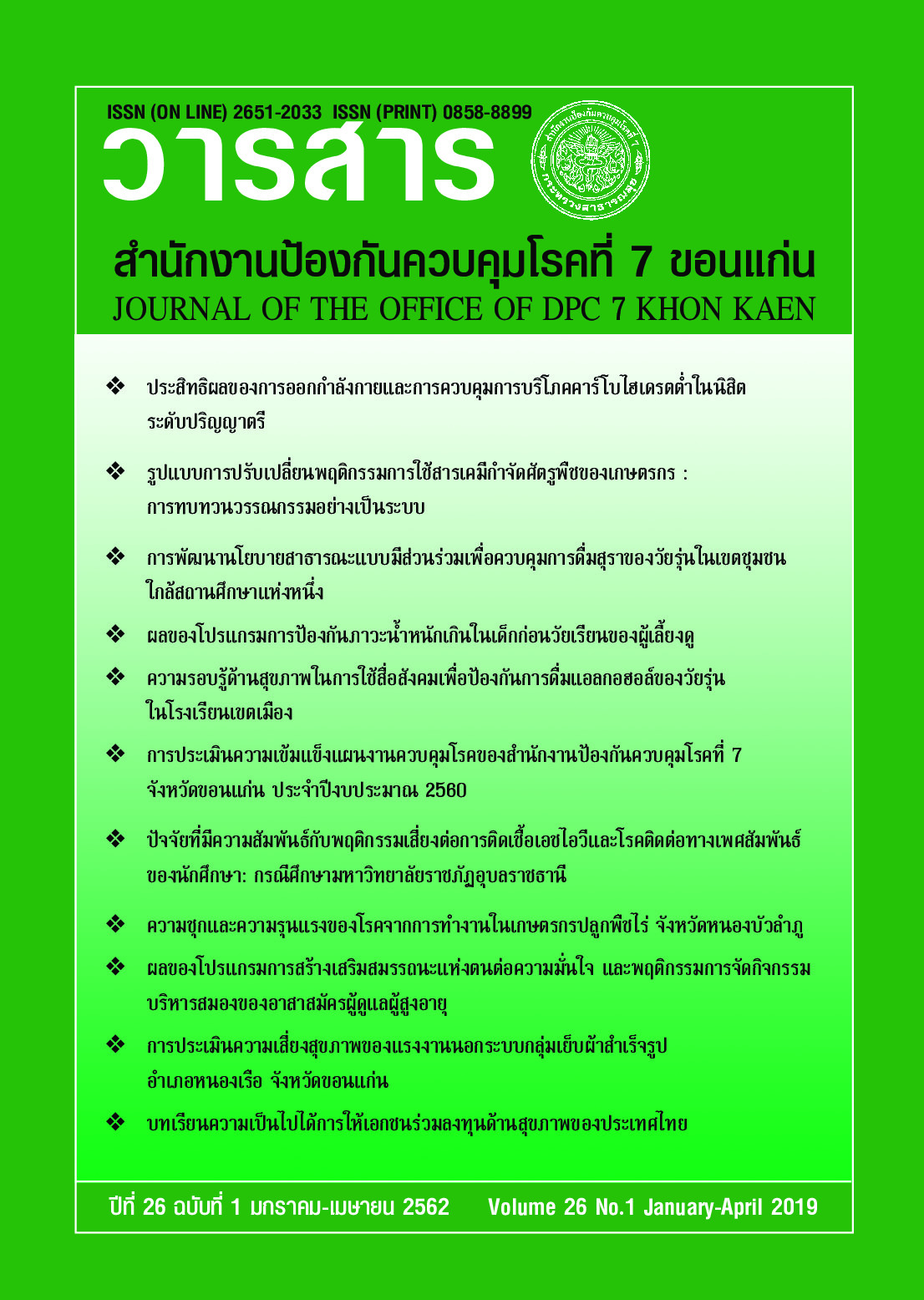ประสิทธิผลของการออกกำลังกายและการควบคุมการบริโภคคาร์โบไฮเดรตต่ำ ในนิสิตระดับปริญญาตรี
คำสำคัญ:
การออกกำลังกาย, การควบคุมอาหาร, การลดน้ำหนักบทคัดย่อ
การศึกษาเชิงกึ่งทดลองนี้มีวัตถุประสงค์เพื่อศึกษาประสิทธิภาพการออกกำลังกายในช่วงลดน้ำหนักด้วยการควบคุมอาหารคาร์โบไฮเดรตต่ำ ระยะเวลา 12 สัปดาห์ของนิสิตระดับปริญญาตรีจำนวน 80 คน ด้วยการเปรียบเทียบดัชนีบ่งชี้สุขภาพ เช่น น้ำหนัก มวลไขมัน ร้อยละไขมันร่างกาย และมวลร่างกายที่ไม่นับรวมไขมันในนิสิตเพศหญิงที่เข้าร่วมกิจกรรมออกกำลังกายในช่วงที่ควบคุมอาหารประเภทคาร์โบไฮเดรตต่ำจำนวน 40 คน เปรียบเทียบกับกลุ่มควบคุมซึ่งไม่ออกกำลังกายตามแผนจำนวน 40 คน ประชากรศึกษาเป็นนิสิตระดับปริญญาตรี ซึ่งเป็นช่วงวัยเปลี่ยนผ่านการดำเนินชีวิตอันส่งผลให้มีโอกาสน้ำหนักร่างกายเพิ่มขึ้น การศึกษานี้ใช้กิจกรรมการออกกำลังกายเชิงโครงสร้างและการควบคุมอาหารประเภทคาร์โบไฮเดรตต่ำ และบันทึกดัชนีบ่งชี้สุขภาพด้วยเครื่องมือวัดองค์ประกอบร่างกายทานิต้า พร้อมกับเปรียบเทียบความแตกต่างระหว่างกลุ่มด้วยสถิติทดสอบค่าเฉลี่ย
ผลการวิเคราะห์ พบว่ากลุ่มนิสิตที่เข้าร่วมการออกกำลังกายและควบคุมอาหารมีน้ำหนักลดลงมากกว่ากลุ่มควบคุมอย่างมีนัยสำคัญทางสถิติ (p<0.001) โดยมีมวลไขมันและร้อยละไขมันร่างกายลดลงมากกว่ากลุ่มควบคุมอย่างมีนัยสำคัญทางสถิติ (p<0.001 และ p<0.001 ตามลำดับ) แต่ไม่พบความแตกต่างอย่างมีนัยสำคัญทางสถิติของมวลร่างกายที่ไม่ใช่ไขมัน (p=0.490) ผลการศึกษาตามสมมติฐานโดยรวมมีความสอดคล้องกับวรรณกรรมก่อนหน้านี้ ซึ่งได้เสนอแนะว่าการการออกกำลังกายในระดับความหนักปานกลางหลายวันต่อสัปดาห์และใช้เวลาอย่างน้อย 30 นาทีต่อครั้งหรือ 150 นาทีต่อสัปดาห์ รวมทั้งวางแผนรับประทานคาร์โบไฮเดรตต่ำ ดังนั้นคำแนะนำจากการศึกษาครั้งนี้สำหรับการลดน้ำหนักจึงควรที่จะได้มีการวางแผนทางโภชนาการด้วยการรับประทานคาร์โบไฮเดรตต่ำ และเพื่อให้บรรลุเป้าหมายของการลดน้ำหนักให้มากยิ่งขึ้นจึงควรที่จะออกกำลังกายควบคู่ไปกับการรับประทานอาหารคาร์โบไฮเดรตต่ำ
เอกสารอ้างอิง
2. แพรวพรรณ สุริวงศ์. ผลวิจัยชี้คนไทยสูญเสียการมีสุขภาพดีถึง 15.3 ล้านปี. [อินเทอร์เน็ต]. 2559 [เข้าถึงเมื่อ 2 มิ.ย. 2559]. เข้าถึงได้จาก: https://www.thaihealth.or.th/Content/31886-ผลวิจัยชี้%20คนไทยเสียการมีสุขภาพดี%2015.3%20ล้านปี.html
3. United States Department of Health and Human Services. The Surgeon general’s Vision for a healthy and fit nation. Rockville, MD: U.S. Public Health Service; 2010.
4. ไทยทริบูน. ผลสำรวจคนไทยติดเหล้า สูบบุหรี่ลดลง โรคอ้วน ความดัน เบาหวานมากขึ้น เผยหญิงไทยมีภาวะอ้วน สูงเป็นอันดับ 2 ในเอเชีย. [อินเทอร์เน็ต]. 2559 [เข้าถึงเมื่อ 15 ส.ค. 2560]. เข้าถึงได้จาก: https://www.thaitribune.org/contents/detail/307?content_id=21742&rand=1469587294
5. American College of Sports Medicine. Guidelines for exercise testing and prescription.
United States: Lippincott Williams & Wilkins; 2009.
6. Mazzeo, R, & Tanaka, H. Exercise prescription for the elderly; current recommendations. Sports Medicine 2001; 31: 992-1008.
7. Center for Disease Control and Prevention. Physical activity guidelines for Americans; How much physical activity do youth need. [Internet]. 2009 [cited 2012 Mar.] Available from www.cdc.gov/healthy youth/physical activity/guidelines.htm.
8. Saris, W, Blair, S, & Van Baak, M. How much physical activity is enough to prevent unhealthy weight gain? Outcomes of the IASO 1st Stock Conference and consensus statement. Obesity Reviews 2003; 4: 101-14.
9. Lee, I, Rexrode, K, & Cook, N. Physical activity and coronary heart disease in women: Is “no pain, no gain” passé?. Journal of the American Medical Association 2001; 285: 1447-54.
10. Galbreath, M. Effects of a high protein diet on weight loss, markers of health, and functional capacity in senior-aged females participating in the curves fitness program.[Doctoral Dissertation]. Waco, Texas: Baylor University; 2008.
11. Noakes, M, Keogh, J, Foster, P, & Clifton, P. Effect of an energy-restricted, high-protein, low-fat diet relative to a conventional high-carbohydrate, low-fat diet on weight loss, body composition, nutritional status, and markers of cardiovascular health in obese women. American Journal Clinical Nutrition 2005; 8: 1298-306.
12. Layman, D, Evans, E, Baum, J, Seyler, J, Erickson, D, & Boileau, R. Dietary protein and exercise have additive effects on body composition during weight loss in adult women. Journal Nutrition 2005; 135: 1903-1910.
13. Nunez, C, Gallagher, D, Visser, M, Pi-Sunyer, F, Wang, Z, & Heymsfield, S. Bioimpedance analysis: evaluation of leg-to-leg system based on pressure contact foot-pad electrodes. Medical Science of Sports Exercise 1997; 29: 524.
14. Heyward, V. Evaluation of body composition. Sports Medicine 1996; 22: 146-56.
15. Field, A. Discovering statistics using IBM SPSS. 4th London: SAGE; 2009.
16. Melanson, E, MacLean, P, & Hill, J. Exercise improves fat metabolism in muscle but does not increase 24-h fat oxidation. Exercise Sport Science Review 2009; 37: 93–101.
17. Powers, S, & Howley, E. Exercise physiology: Theory and application to fitness and performance. New York, NY: McGraw-Hill 2004.
18. Mokdad, A, Serdula, M, Dietz, W, Bowman, B, Marks, J, Koplan, J, The spread of the obesity epidemic in the United States. JAMA 1999; 282: 1519-22.
ดาวน์โหลด
เผยแพร่แล้ว
รูปแบบการอ้างอิง
ฉบับ
ประเภทบทความ
สัญญาอนุญาต
ความรับผิดชอบ
บทความที่ลงพิมพ์ในวารสารสำนักงานป้องกันควบคุมโรคที่ 7 ขอนแก่น ถือเป็นผลงานทางวิชาการหรือวิจัย และวิเคราะห์ตลอดจนเป็นความเห็นส่วนตัวของผู้เขียน ไม่ใช่ความเห็นของวารสารสำนักงาน ป้องกันควบคุมโรคที่ 7 จังหวัดขอนแก่น หรือ ของกองบรรณาธิการแต่ประการใด ผู้เขียนต้องรับผิดชอบต่อบทความของตนเอง
ลิขสิทธ์บทความ
บทความที่ได้รับการตีพิมพ์จะถือเป็นลิขสิทธิ์ของสำนักงานป้องกันตวบคุมโรคที่ 7 จังหวัดขอนแก่น




